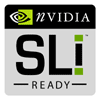Page 3
Dual 16x PCI-Express lanes
Next to overclocking, this is why you buy the mainboard, really. A nice feature for high-performance SLI gamers are the fact that you have two dual 8GB/s bandwidth over two graphics ports. Now the original 680i SLI mainboard had a third x8 physics/graphics ports, that one is stripped. Yet you do get 2x 1x16 PCI-Express lanes at your disposal... not a huge deal over 2x 1x8 yet with uber-high-end graphics cards; it can make a small difference as the cards will have more data bandwidth to work in.
The two times x16 PCIe bandwidth is split between the SPP and MCP chip, just like the original 680i mainboard.
Networking
A great feature on the 680i mainboard was the fact that you'll get two 1GBit Ethernet ports, which you could actually bind together as one 2 GBit/s connection.
Agreed it was a little excessive for most of us, but it might be "neat" function to have on a LAN party as a server. This feature was stripped. You'll now have one 1000/100/10 MBit/s Ethernet connector at your disposal. For the most of you this is enough; me personally... I have a secondary subnet here in the office and really believe that today's mainboards should have at the very least two Ethernet connectors; hey we live in 2007. [Ed - or in a world of more than one subnet!]
So for a 200 USD mainboard this is one step too far for me. This was an unnecessary step as I'd really miss the second NIC.
Furthermore features like TCP/IP Acceleration are still present and so is FirstPacket. A fun feature, for gamers. When you are playing on-line / or in LAN or hey... what about VOIP? Don't you hate it that you for example can't have any other outbound traffic from, for example, an FTP or Bittorrent client for all I care? Doesn't your ping time go AWOL? Yes, outbound traffic will kill off your ping times making it barely impossible to play on-line very well.
This is where NVIDIA FirstPacket comes in. At the NVIDIA control panel you can now prioritize your network traffic. So if you set a game like Serious Sam 2 with higher priority your ping times will remain fantastic as all other traffic will be lower in the data packet queue.
SLI Memory
 You already have been able to learn about DDR2 EPP (SLI memory) recently as it was covered in our earlier reviews. It's very clever technology for the overclocker who does not dare or know how to configure memory at it's best in an overclocked environment.
You already have been able to learn about DDR2 EPP (SLI memory) recently as it was covered in our earlier reviews. It's very clever technology for the overclocker who does not dare or know how to configure memory at it's best in an overclocked environment.
DDR2 memory (actually pretty much any memory) uses an SPD (Serial Presence Detect) chip to store its JEDEC certified timings and setup specifications on. Now a massive chunk of that SPD chip is being written as ZERO; meaning it's largely unused space. A couple of guys at NVIDIA figured... hmm, let's talk to some memory allies and see if we can do something with that extra space and utilize it for our new products to offer our buyers more options.
Since most memory is configured at JEDEC specifications the standard timings are not exactly enthusiast presets, most of us know, we can do a heck lot more with memory timings and frequency wise then the rather safe JEDEC SPD settings tell the BIOS to fire off on your memory.
Once you overclock the system bus, your memory clock will run faster in MHz also. A higher FSB usually means that we'll need slower timings and/or different voltages, that kind of information could be stored into the SPD in several profiles.
So basically additional non-JEDEC specified timings related towards a certain clock frequency or related to multipliers/dividers/voltages/drive strengths will be stored on that unused SPD space. This way that memory can be setup in a different way with the click of a button, or even better detected by your nForce 680i mainboard and set automatically.
So in short: you can tweak memory really easy yet this is intended for the folks that have a hard time overclocking themselves. It's a reasonably fool proof method of getting the best out of your DDR2 memory with an NFORCE series 590 or 680 mainboard. Obviously you can manage memory timings and everything related to it manually also. This is just an extra feature.
Look out in the stores for memory with a "SLI Ready" logo and I honestly think this is a great feature ! The nForce 680i LT mainboard supports DDR2 SLI memory up-to 800 MHz. But you can easily set and configure it higher (even 1200 Mhz I think) in the BIOS of you choose to do it manually (which is doing the opposite of SLI memory though). The ability to asynchronously run the memory from the FSB it courtesy of an automated memory ratio setting in combo with an extra PLL on the mainboard. NVIDIA in fact is marketing this under the name NVIDIA QuickSync Technology.
Quite frankly, it's a lovely feature.
